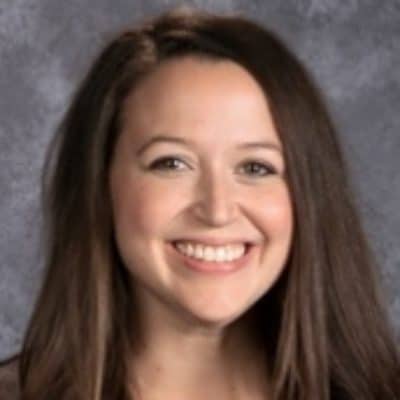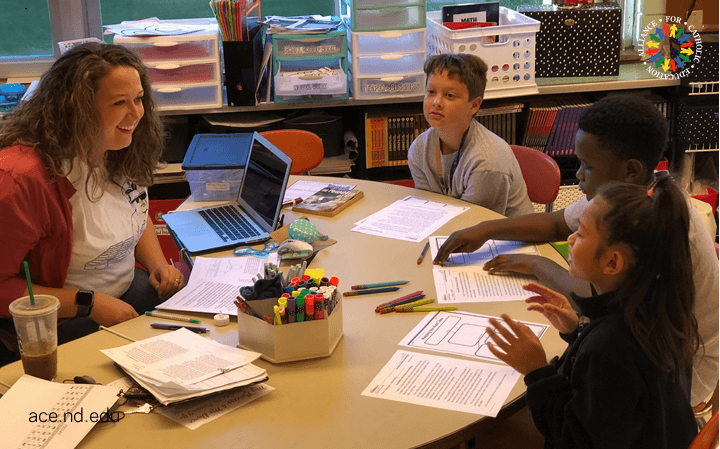We are thrilled to feature for the very first time a classroom from one of the Higher-Powered Learning Program schools in Minnesota! Read on to learn more about one of the most innovative classrooms in the program and what Rachael Hillman has learned in her first few months of blended learning.

If you walked into Rachael Hillman's classroom last year, you may have already thought she was doing blended learning–I'll admit that I thought she might be when I visited last spring! For the past few years, Rachael has been experimenting with different classroom models and activities that would give her students a more interesting learning experience. "I was already incorporating different modes of learning for my students to keep them engaged and interested," Rachael explained in one of our recent conversations. "I was happy with the structure of my classroom and honestly didn't think that blended learning should have to change it."
Though we didn't explicitly mandate any changes to her classroom, Rachael quickly realized this summer that she would have to make some significant changes if she wanted to maximize the impact of the blended model. Her classroom does not look dramatically different than it did last year, but a number of subtle changes have already made an enormous difference in her students' learning.
Re-evaluating the Purpose of Each Station
Last year, Rachael's class used a variety of free online programs and offline activities in their learning that the students really seemed to enjoy. So when Rachael realized that she would be incorporating a different online program based on our recommendations this year, she wasn't thrilled. "At first, I felt like the new online program we chose was forcing me to give up other online activities that my students and I loved," Rachael told me, "but it has ended up being a much better use of time than other programs because it engages the students in really high-quality, personalized instruction."
Even more importantly, though, incorporating a new program forced Rachael to re-evaluate the purpose of each of her stations. "I knew I couldn't just add another station to the ones I used last year, so I had to think about the learning goal for each of activities and whether or not they were actually purposeful. I was definitely resistant at first, but now I feel like every single activity that takes place in my classroom is 100 percent purposeful, which is really increasing the learning that's happening in my class."
Personalizing Instruction for Each Group
 Another idea that initially made Rachael uncomfortable was differentiating instruction for each of her small groups. We always tell teachers that if they are repeating the exact same lesson for each of their small groups, they are wasting their time. Many teachers find this idea comforting, but Rachael did not. "I did a lot of small-group instruction before, but the idea of having a different lesson for each group was overwhelming. I didn't know how I would plan for that and make time for so many different lessons.
Another idea that initially made Rachael uncomfortable was differentiating instruction for each of her small groups. We always tell teachers that if they are repeating the exact same lesson for each of their small groups, they are wasting their time. Many teachers find this idea comforting, but Rachael did not. "I did a lot of small-group instruction before, but the idea of having a different lesson for each group was overwhelming. I didn't know how I would plan for that and make time for so many different lessons.
"I quickly realized that it wasn't as difficult as I imagined it would be," Rachael said. "I'm still getting the hang of it, but I definitely approach every lesson with the idea that each group is going to need something a little different to reach our objective. I just have to think about what each group needs and how I am going to make sure they get it in our small-group instruction time."
Creating a More Fluid Schedule to Meet Students' Needs
And just as she knew that each group would need something different from her, Rachael realized that each group would need different learning activities throughout the week as well. Instead of having each group work through the same activities every day, Rachael created a unique schedule for each day of the week so that all five days together form a comprehensive, personalized instruction flow for each student.
For example, Rachael incorporates five different activities into her reading instruction: small-group, i-Ready, word work, fluency, and literacy games. One student does small-group, i-Ready, and word work every day, but only does fluency and literacy games a few days a week. Another student might actually do word work multiple times on some days and not visit i-Ready or literacy games every week. Rachael very thoughtfully created this schedule to meet each student's individual needs and keep all students engaged throughout the week. Needless to say, we were BLOWN AWAY by the effort she put into this model and the benefits it is already having for her students.

Rachael is less than two months into her blended-learning implementation, but we are already so excited by the progress we see in her classroom! Stay tuned to learn more about the innovative ideas our Higher-Powered Learning Program teachers are putting in place in their classrooms.
 Alliance for Catholic Education
Alliance for Catholic Education
